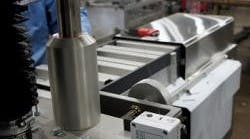Precise, repeatable positioning of a machine’s moving parts is accomplished with COT2, a changeover tool that records and stores the optimum setting.
Production professionals cringe every time a customer requests a product variation that will require a changeover. The challenge has less to do with the time spent changing machine settings to accommodate the change than in returning the line to a steady state.
Most of today’s food-plant changeovers occur in the packaging department and involve different primary packages or different case packs and other variations in secondary packaging. Many food processors have instituted center-line programs in which score marks or other visual aids guide operators in recalibrating machine settings, but readjustments while complex machinery is running usually still are needed, maintains Dragan Filipovic. The electrical engineer began focusing on the issue 20 years ago, first as a controls engineer with a packaging machinery manufacturer and then as associate principal scientist with Kraft Foods.
“Mechanics introduce variance by insisting they know how to set a machine better than anyone else,” says Filipovic. Even when operators and mechanics follow scribe-mark protocols, fractional deviations from the precise setting cause big problems for high-speed cartoners, casepackers and other machinery with 30 or more changeover locations.
Filipovic’s solution is COT2, shorthand for changeover tool-second generation. He originally commercialized the system five years ago through his small start-up firm, Manufacturing Improvement Devices Inc. Based on feedback from manufacturers, multiple refinements have been made (a tablet PC replaced the original netbook, and the system now has an industrially hardened potentiometer — essentially a retractable tape measure).
The tool consists of three pieces of hardware: the Windows-based tablet, a microprocessor-equipped wireless sensor bundled with the potentiometer and nonmagnetic brackets and hooks which are attached to the machine. Operators mount the sensor on a given bracket and run the potentiometer’s string to a hook on the movable machine part. LED indicators then guide the operator in dialing in the distance to within 0.7mm of a predetermined optimal setting. As many as 50 set points per machine are stored in the tablet’s memory, where all the changeover “recipes” also reside.
Before the optimum settings for a changeover are determined, a machine’s condition must meet the OEM’s equipment standard. Recording a center-line number on a machine experiencing bearing wear or other mechanical deviations results in “chasing data” that is unreliable and constantly changing, one end-user says. That critical first step was not understood by Filipovic, whose turf is a lab, not a production floor, this food manufacturer notes. He credits the efforts of Tom "Chico" Dunhoft in repairing deficient machines on his plant floor for his success with COT2.
The guidance operators receive from COT2 has helped to reduce changeover times by 33-50 percent, he says, “but the big dollar saving is the vertical startups.” Prior to using COT2, four hours typically elapsed before a line would return to 90 percent OEE. With the system, that efficiency level is reached in about 5 minutes.
“I wasn’t sold on COT at first,” confesses Dunhoft, owner/operator of TSD Packaging Inc., a Bradenton, Fla., service company that is acting as COT2’s sales and distribution representative. “My concerns were addressed, and now it’s a system I’m very comfortable with.” He usually needs two days to mount the brackets and peg points on machines and establish the optimum settings for the recipes, working alongside a plant “super user” with good computer skills who will repeat the process on other lines.
COT2 users have found additional benefits for the system. During or at the end of a production run, one manager says machine measurements are rechecked to determine if any drift has occurred, an early indicator of machine failure. Preventive maintenance is then requested. Another manufacturer reports machine jams might occur despite precise settings, an indication that suppliers of paperboard and other packaging materials are delivering out-of-tolerance stock.
The camera feature of tablet PCs has been used by one plant to provide a visual guide to a problem area on equipment.
The electronics and logarithms behind COT2 are complex, but the device’s use is simple, according to Filipovic, who lives and works in Munich, Germany, and relies on his college-age son to support MID domestically.
Resistance to change is human nature, but he believes the tool’s simplicity can ease the acceptance process. “Job complexity for a mechanic or operator doing classical changeovers is very high,” Filipovic says. “COT2 is like GPS in your car: it guides you to perfect changeover settings, first time and every time.”


